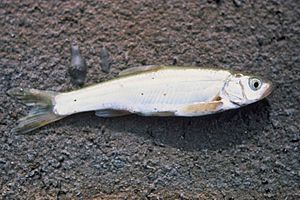Virgin spinedace facts for kids
Quick facts for kids Virgin spinedace |
|
|---|---|
 |
|
| Conservation status | |
| Scientific classification |
The Virgin spinedace (scientific name: Lepidomeda mollispinis) is a type of fish that lives in the Virgin River. This river is a branch of the big Colorado River in the United States.
This fish is mostly silvery with a shiny, brassy look. It has dark spots or speckles on its sides. The fin on its back, called the dorsal fin, has eight rays. Two of these rays are spiny, and the second spiny ray is longer than the first. The fin on its belly, called the anal fin, usually has nine rays.
When male Virgin spinedace are ready to breed, they become much brighter in color. They get a band on their anal fin, and their other fins turn orange or red. They also have a red or gold spot near their gill slit. Adult Virgin spinedace are usually about 6 to 12 centimeters (about 2.4 to 4.7 inches) long. The Virgin spinedace eats many different things, but mostly aquatic insects that live in the water.
Virgin spinedace like to live in clear water that is about 1 meter (3 feet) deep. They prefer places with cover, like overhanging bushes or riverbanks, and near plants. They also like areas with sand or gravel at the bottom. These fish prefer slow-moving water where there isn't heavy flooding. They can handle warm water temperatures, even up to 29 °C (85 °F) or higher. This helps them survive in summer when parts of the river might dry up, forcing them into small, isolated pools. They like clear, cool streams that flow fairly fast, often using areas where the current changes speed.
Contents
Where Virgin Spinedace Live
Virgin spinedace can be found in many parts of the Virgin River and its branches in Utah, Nevada, and Arizona. Some of these places include the North Fork and East Fork of the Virgin River, Shunes Creek, North Creek, Ash Creek, La Verkin Creek, Leeds Creek, Quail Creek, Moody Wash, Magotsu Creek, the Santa Clara River, and Beaver Dam Wash.
How Fish Populations Change
By 1994, the number of Virgin spinedace had dropped a lot. They were found in only about 60% of the places they used to live. Because of this, there was a plan to list them as a threatened species under the Endangered Species Act (ESA).
To help the fish, the Virgin Spinedace Conservation Agreement and Strategy (VSCAS) was created in 1995. This plan aimed to improve the conditions that caused their decline, make their homes better, and bring them back to areas where they had disappeared. The main goal of the VSCAS was to increase the areas where the fish live from 60% to at least 80% of their historic habitat.
The VSCAS has been very successful! Local, state, and federal groups have worked together to stop the decline of the Virgin spinedace. They have even helped the fish spread to new areas. Since 1995, the areas where Virgin spinedace live have increased by 71.7 kilometers (44.6 miles). This includes places like the main Virgin River, Santa Clara River, Beaver Dam Wash, and Quail and Leeds creeks.
Even with challenges like droughts, wildfires, and floods, the Virgin spinedace now live in 90.6% of their historic habitat. They have also expanded into an additional 10.0 kilometers (6.2 miles) of new areas. Today, healthy populations of Virgin spinedace live in 222.2 kilometers (138.1 miles) of streams across the Virgin River basin.
Protecting Virgin Spinedace
The biggest problems for Virgin spinedace are:
- Water use: How water is taken from the river for human use.
- Habitat damage: Changes that harm their living areas.
- New species: Other fish or animals that are not native to the area and compete with them.
The VSCAS plan focuses on several important actions:
- Restoring water flow: Making sure there is enough water in the streams for the fish to survive.
- Improving habitats: Fixing and restoring the places where the fish live.
- Controlling non-native species: Removing or managing species that don't belong and harm the spinedace.
- Connecting habitats: Making it easier for fish to move between different parts of the river.
- Keeping genes healthy: Ensuring the fish populations stay strong and diverse.
The VSCAS also includes monitoring the fish populations. This helps scientists track how well the fish are doing and if the conservation efforts are working.
See also
 In Spanish: Lepidomeda mollispinis para niños
In Spanish: Lepidomeda mollispinis para niños


